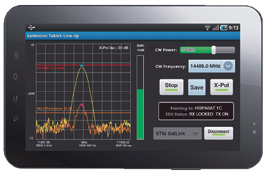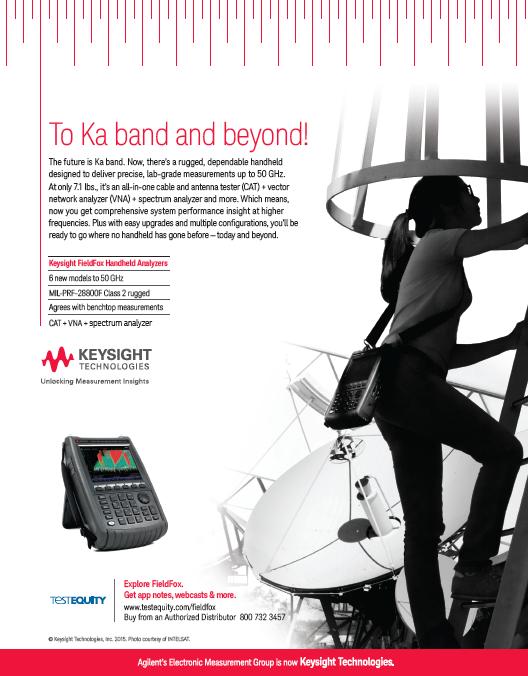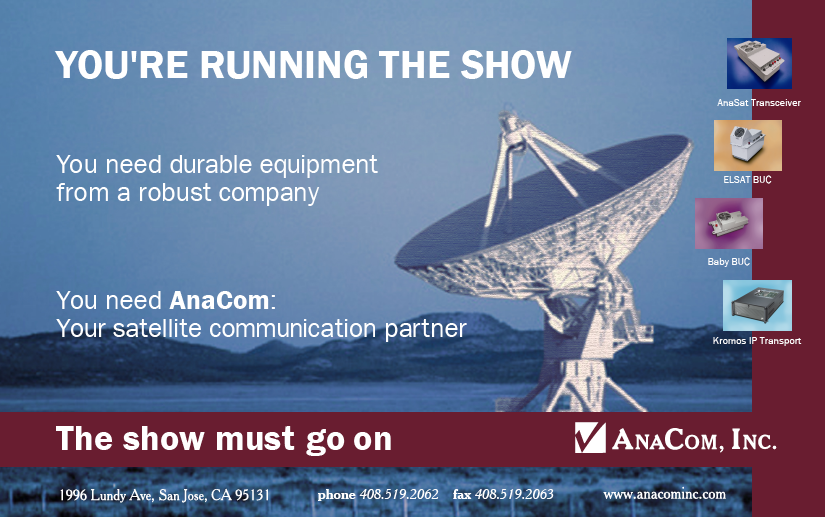The satellite industry has changed dramatically over the past few years, thanks to the advent of the first High Throughput Satellite (HTS) systems and the commitment of satellite operators both large and small to roll out their own unique HTS designs that promise much higher capacity at a much lower cost per bit being delivered to the user.

Integrasys’ SatMotion Pocket.
The first HTS offerings allowed service providers to compete with terrestrial connectivity in the direct-to-consumer market and were primarily rolled out in North America and Western Europe. As new HTS design concepts become reality, the range of target markets significantly increases for service providers who are seeking to leverage the new economical models that HTS provides. The new spacecraft innovations being rolled out will allow service providers to cost-effectively support the high throughput, carrier-grade applications that are common within the oil and gas, cruise and cargo, premium enterprise and cellular backhaul markets.
The emergence of these current and impending HTS implementations provide the potential of Very Small Aperture Terminal (VSAT) modems that are being used within a satellite network to be much more efficient and to also support the increased throughputs that users demand, all the while providing high availability and reliability. As such, HTS has already had an impact on VSAT deployments as satellite service providers look to the skies for innovation and to the ground for future-proof technology that allows them to unleash the potential of these next generation spacecraft when they are available.
This forward-looking optimism is set to increase further—Northern Sky Research estimates that the broadband VSAT market will reach $10 billion by 2021. Similarly, IT Market Research Reports estimate that the enterprise VSAT market will grow at a CAGR of 10.49 percent between 2015 and 2018, a period that will see a significant increase in space segment supply due to HTS rollouts during this time period.
A successful HTS-based service must be based on scalable, flexible network solutions that are easily deployable and can allocate higher throughputs when and where the demand is highest at any specific time. The scalability of a ground platform is key, as the capital expenditure (CAPEX) costs to build out the network over time must mirror incoming revenues as much as possible.
Comtech EF Data has designed its new Heights Networking Platform with the HTS service provider in mind, teaming the ground equipment scalability and flexibility required in a spot beam environment with the horsepower, efficiency and intelligence to leverage the full range of next generation spacecraft design advantages, thereby enabling service differentiation. The most net efficient and powerful platform in the industry, the Heights Networking Platform leverages a single comprehensive user interface combined with a powerful traffic analytics engine that enables the service provider to easily design, implement, monitor, control and optimize their entire satellite network.
As a satellite network grows and multiple remotes are concurrently brought onto the network, it is imperative to minimize the difficulty associated with the commissioning of a remote as well as for the long term performance of the network—all must be of the highest quality in terms of satellite link integrity and interference mitigation. Only through the proper remote commissioning solution can the utilization of costly network resources be maximized while also maximizing the Quality of Experience (QoE) of the end user.
To this end, Comtech EF Data has teamed with Integrasys to develop the Comtech remote commissioning system, Satmotion Pocket. This offering has already received widespread industry acceptance, having been named the recipient of both the Most Innovative Product at SatCon and the Most Innovative Technology award at VSAT 2015.

Comtech EF Data HEIGHTS Networking Platform illustration.
Simply put, Satmotion Pocket allows satellite service providers to save both time and money when deploying remotes on satellite networks. Traditionally, accessing a satellite has been a labor intensive process as remote installers needed to interact with satellite operators in real-time to achieve certain interference isolation thresholds.
The process of antenna repointing and remote carrier level checking required a significant amount of manual labor and waiting on-site, keeping the costs of remote installation high and the number of remotes that an installer could bring onto a network in a day at a low rate. The Satmotion Pocket solution significantly simplifies this process and minimizes the back-and-forth required to attain a quality installation.
This quick installation time benefits the satellite operator, the satellite service provider and, most importantly, the end user. The use of Satmotion Pocket makes each installation simpler as well as minimizes the chance for post-installation issues onsite that may require a site revisit to troubleshoot the problem.
HTS maximize throughput through frequency re-use. A given range of spectrum (Ka-, Ku-, C-band) is re-used several times into multiple, geographically disperse, beam locations. Each range of frequencies within the band can use used in different beams with the beam locations determined by the desired level of interference for the given application.
The more tolerant an application is to interference, the closer two beams using the same spectrum can be located to one another. Highly oversubscribed, consumer-based offerings fall into this category and, therefore, beams using the same frequencies can be placed closer together. This allows the spacecraft to re-use the band many more times, creating a more “sellable” bandwidth from a macro-level, satellite perspective.
This type of design works well for low availability applications but does not work for carrier-grade applications that require a higher “quality” of bandwidth. These applications demand much higher spectral efficiencies to/from individual remote sites with much higher link availabilities than consumer-grade applications.
In those cases, interference must be minimized to create better spectral efficiencies and higher availabilities and, therefore, beams sharing a common range of frequencies must be placed further apart. The teaming of the Satmotion Pocket and Comtech EF Data Heights Networking Platform solutions allow each remote installation to maximize long-term link performance to each site on a network.
Three types of topologies are possible in an HTS design:
• Star: Provides interconnectivity between user beams and gateway beams
• Mesh: Provides connectivity between user and/or gateway beams
• Loopback: Provides connectivity within the same beam.
The benefits of Satmotion Pocket can be leveraged for any of these network topologies. In addition, Satmotion Pocket can be customized to fit any business models. In the case of a vertically integrated (full managed service) model, Satmotion Pocket service would be provided through all satellite beams as the satellite operator owns the network and ground infrastructure—this equates to the requirement of a single Satmotion server unit at each gateway.
This configuration would allow the automation of lineups for all user beams to be accomplished, as each user beam is connected to a gateway beam. For hub co-location and VNO models, a Satmotion server will be required only in the gateways which manage the target user beams. This is a cost economical option for service providers that will not be installing units on each Gateway.
The Satmotion system is a software-based tool that allows VSAT installers to autonomously measure their uplink test signal in the field with no need to coordinate with NOC personnel. Uplink signal measurements are taken at the NOC site with a spectrum analyzer along with a controlling software server.
The installer receives measurements from the target satellite through the same VSAT that is being commissioned. He or she is then able to point the antenna properly during transmission versus the traditional method of performing this task during reception, which results in a higher quality link. The traditional method of reception-based pointing is adversely affected by squint error along with possible transmission issues during installation. The Satmotion Pocket solution avoids the long-term, network-wide costs associated with such issues.
In summary, the introduction of next generation spacecraft into the satellite communications market is well underway, with these new spot beam HTS offerings promising more capacity, higher throughputs, stronger efficiencies and a lower cost per bit delivered.
Only through the proper selection of complementary ground equipment solutions will higher performance levels and more cost-effective economics become a reality. Service providers that hope to penetrate or continue success within the oil and gas, cruise and cargo, premium enterprise and cellular backhaul markets must wisely select the appropriate ground equipment solution providers to succeed in this HTS new world.
Ground solutions must be scalable and flexible enough to grow and adapt while offering the combination of horsepower, efficiency and intelligence to support tomorrow’s traffic mix reliably today.
The combination of Comtech EF Data’s Heights Networking Platform with the award-winning Satmotion Pocket commissioning tool enables the service providers that will be successful in these markets to tie infrastructure and operating costs to revenue while providing the differentiated service that is needed today to stand above the noise of “me-too” offerings.
An Ingtegrasys SatMotion Pocket Datasheet PDF is available for viewing or download at www.integrasys-sa.com/datasheets/satmotp.pdf

For additional information regarding Comtech EF Data’s Heights Networking Platform, please visit www.comtechefdata.com/products/heights/

Steve Good is Vice President, Marketing for Comtech EF Data, leading the company’s marketing, market development and business development functions, objectives and initiatives based on long-term product and profitability goals.
Steve has held senior management, marketing, product management and engineering positions with Intelsat, most recently as Vice President, Network Services, along with Verestar, Viacast and Hughes Network Systems. Also a former member of the Comtech EF Data team, Good previously held the position of Vice President, Sales Engineering.
Alvaro Sanchez is Sales and Marketing Director at Integrasys. Alvaro is responsible of Satellite Carrier Monitoring at Integrasys for providing most innovative solution to satellite operators and service providers. Currently Alvaro is the head of the USA office in DC area. Prior to join Integrasys, Alvaro was a signal analysis expert at CERN European Organization for Nuclear Research.



